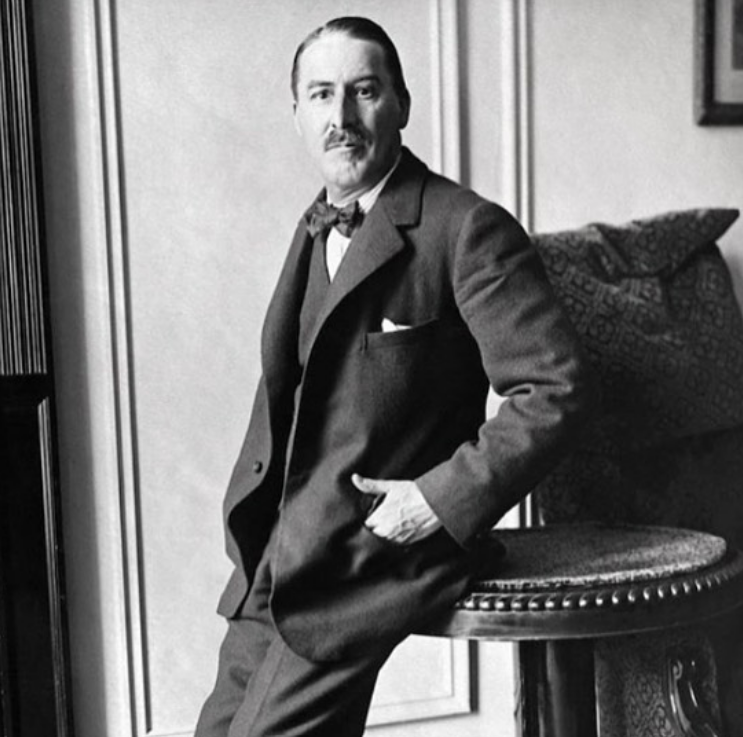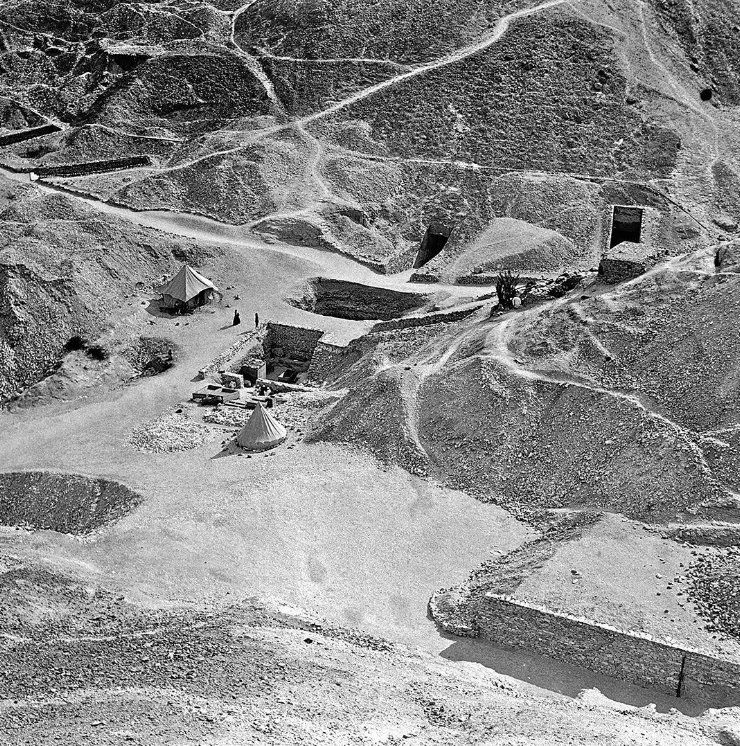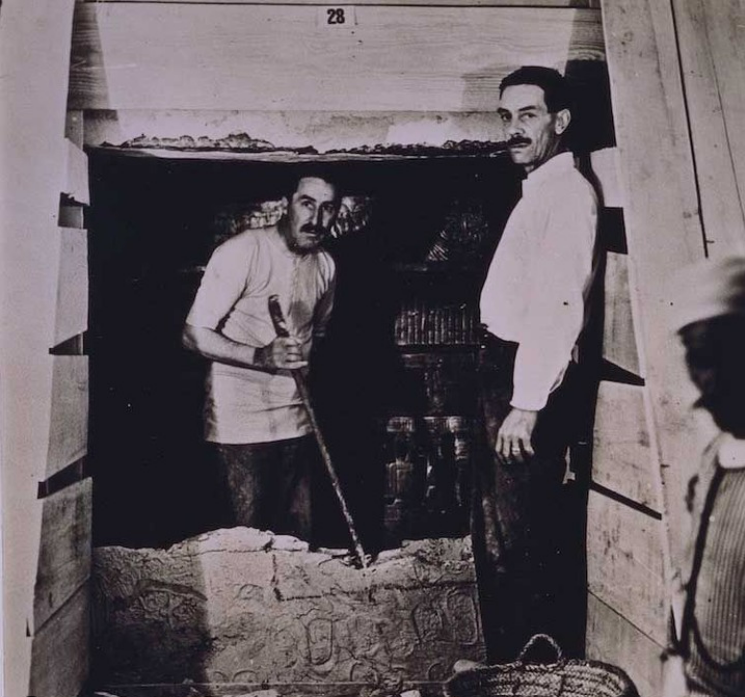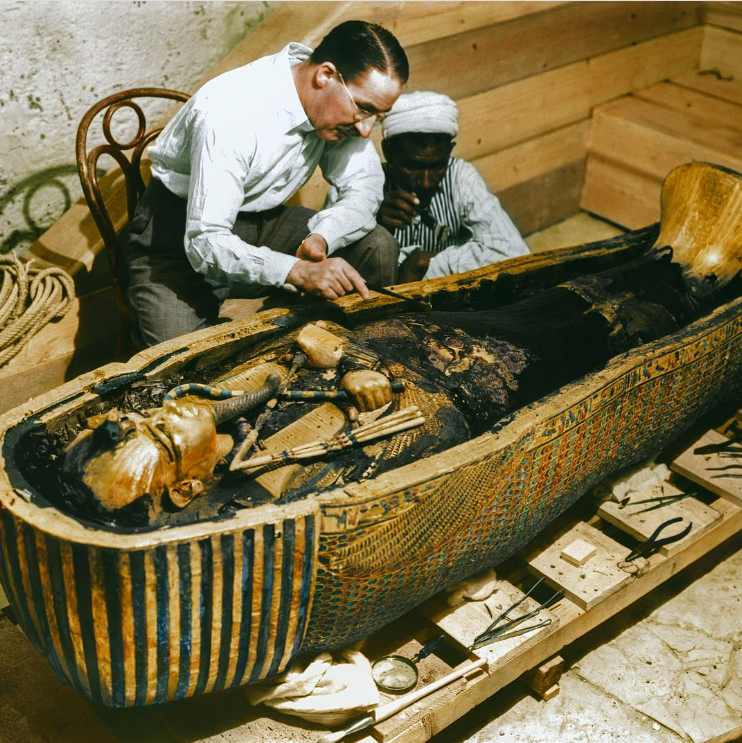In February 1923, archaeologist Howard Carter unsealed the door to the burial chamber of Pharaoh Tutankhamun, after years of searching for the elusive King Tut’s tomb. Carter’s determination and eventual discovery became a global obsession, with the beautifully preserved sarcophagus and the treasures of the tomb astonishing the world. Now 100 years on, we relive the fascinating story of how King Tut’s tomb was discovered after 3,000 years, becoming the most important archaeological discovery of all time, and how a once-forgotten king became a modern icon.
Who was Howard Carter?

Howard Carter was a British archaeologist and Egyptologist, best known for his 1922 discovery of the tomb of the King Tutankhamun (King Tut) in the Valley of the Kings in Egypt. Carter began his career as an Egyptian antiquities inspector and artist, selling watercolour paintings to tourists in Egypt. His dream was to excavate the Valley of the Kings in Luxor. In the early 19th century, Western tomb raiders and excavators had uncovered numerous royal tombs, but only a few people held rights to excavate in the valley.
After studying the valley, Carter was sure there were still tombs to be discovered, including the elusive tomb of King Tutankhamun, an 18th Dynasty pharaoh. King Tut was one of the few pharaohs whose tomb and mummy had never been found.
In 1914, the reigning excavator of the Valley of Kings, American lawyer Theodore Davis, relinquished his rights to dig in the valley. While he and most other Egyptologists believed there was nothing more to find in the valley, Carter was set on his theory that King Tut’s tomb lay here. He scored a patron, the English aristocrat George Herbert, Earl Of Carnavon, who funded his excavations and was ready to dig. World War 1 broke out soon after and Carter waited another three years before he could finally chase his dream.
A licence to dig
Carter’s team of local workmen set to work in the quarry. These men were responsible for the real labour behind the discoveries in the valley. They performed back-breaking work as they, quite literally, moved mountains excavating the earth from the valley. They worked for five fruitless years, finding barely anything.
In 1922, Carnavon was about to pull the plug on the whole project. It was then that Carter told Carnavon about the labourer’s discovery of the remains of ancient workmen’s huts in front of Ramses VI’s tomb. The huts dated back to the 19th Dynasty, after King Tut’s time. All signs pointed to this being the most likely place to find a nearby 18th Dynasty tomb. In October 1922, Carnavon granted Carter permission to return to the valley for one last season to find King Tut’s tomb.

Uncovering King Tut’s Tomb
On November 4, 1922, Carter’s team discovered a step in the bedrock under one of the huts. They continued to dig and found a staircase that lead to a door with the 18th Dynasty official seal of the Royal Necropolis intact. Carter broke through the door and found a passageway filled with rubble, further evidence of an untouched tomb.
On November 5, Carter wrote in his journal: “It was a thrilling moment for an excavator, to suddenly find himself, after so many years of toilsome work, on the verge of what looked like a magnificent discovery—an untouched tomb.”
Carter sent a cable to Carnavon telling him of his exciting discovery and Carnavon arrived in Luxor on November 22. By November 26, the workmen had uncovered the lower part of the door, showing the cartouche of Tutankhamun. They had also cleared the passageway, leading to a second sealed door. Carter cleared the stones to create a hole through the top of the door, and entered the tomb, candlelight in hand. When Carnavon asked, “Do you see anything?”, Carter famously replied, “Yes, wonderful things.”
In his journal, Carter wrote: “It was sometime before one could see, the hot air escaping caused the candle to flicker, but as soon as one’s eyes became accustomed to the glimmer of light the interior of the chamber gradually loomed before one, with its strange and wonderful medley of extraordinary and beautiful objects heaped upon one another.”

The treasures of King Tut’s tomb
After thousands of years of darkness, Carter and his team shone a light on one of the most extraordinary archaeological discoveries in history. They saw incredible treasures including a golden throne, ebony statues, gilded couches, and ornamental caskets. There were carved chairs, bronze musical instruments, gold chariots, gold-sequined clothing, gold sandals, and all kinds of priceless ornaments and objects. Now, Carter faced the challenge of retrieving and preserving more than 5,000 delicate artefacts, all while facing a global media frenzy over the discovery.
Discovering the burial chamber

The tomb was made up of different rooms and chambers. The most prized of these was King Tut’s burial chamber. Carter finally unsealed the burial chamber and the pharaoh’s sarcophagus on February 16, 1923. The chamber was strewn with paintings and gilded shrines. In the middle was the remarkable pink quartzite sarcophagus, protected by carved reliefs of winged goddesses.
Carter recalled the opening of the sarcophagus as the “supreme and culminating moment” of the whole discovery. He raised the 2,500-pound stone lid with a pulley system in front of an audience of officials. When he rolled back the shrouds covering the contents of the sarcophagus, Carter said, “a gasp of wonderment escaped our lips, so gorgeous was the sight that met our eyes.”
They came face to face with King Tut, a seven-foot-long figure made of gold-covered wood. They would soon discover this was the first of three nesting coffins, all intricately decorated. The third and final coffin was made from solid gold. The figure inside had its hands clasped across its chest, holding a sceptre made of gold. The twin heads of a cobra and vulture were mounted on the golden forehead, representing the immortal king.
Carter wrote in his journal: “Many and disturbing were our emotions. Most of them voiceless. But, in that silence, to listen – you could almost hear the ghostly footsteps of the departing mourners.”
The New York Times called it “perhaps, the most extraordinary day in the whole history of Egyptian excavation.” The journalist wrote, “It finally ended in a wonderful revelation, for before the spectators was the resplendent mausoleum of the king, a spacious and beautifully decorated chamber completely occupied by an immense shrine covered with gold inlaid with brilliant blue faience.”
What happened to King Tut’s tomb?
The tomb of King Tutankhamun was one of the most well-preserved tombs ever found. Remarkably, thousands of years later, the sarcophagus and mummy were still almost fully intact. Howard Carter would go on to catalogue over 5,400 items found in King Tut’s tomb. Carter later returned to Britain as a distinguished museum curator.
The objects discovered in King Tut’s tomb will now be displayed in the Egyptian Museum in Cairo. King Tut’s sarcophagus and mummy were returned to the tomb and you can view them on tours.

King Tut’s Legacy
King Tutankhamun has become one of the most well-known pharaohs of Ancient Egypt. But his life on earth tells a remarkably different story. He began his reign when he was just nine years old, ruling from 1333 BCE until his untimely death at age 19 in 1323 BCE. While his death remains a mystery and some say it was murder, scientists say he most likely died from a broken leg and subsequent infection.
His reign was considered insignificant compared to other great rulers like Ramses or Thutmose III. King Tut was buried in a relatively small, cramped tomb for the pharaohs of the times. He also traditionally should have been buried close to family in the Western Valley. Some theories say that because he died so young, he was unable to finish his intended grand tomb. Another theory is that Tutankhamun’s successor, Ay, strategically swapped out the tombs, and saved for himself the more spectacular tomb in the Western Valley, close to the tomb of Amenhotep III., Tut’s grandfather.
We may never know the true story, but the fact remains that King Tutankhamun was hidden from the world for more than 3,000 years. He lay in his gilded tomb, undisturbed through millennia of empires, civilisations, wars, and natural disasters. But this once-forgotten king has since transformed into an ancient icon, captivating the world and inspiring countless film, exhibitions and art. Today he’s one of the most renowned ancient rulers of all time and his intact royal tomb has given historians a wealth of information about Ancient Egypt.
Over a century later, we’re still fascinated by it all. From Howard Carter’s unwavering determination to the Egyptomania that gripped the world, and the intriguing story of King Tutankhamun himself, this is a story that will be told for centuries more.










Join the Discussion
Type out your comment here:
You must be logged in to post a comment.